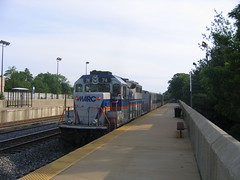 Transit Tuesday is a weekly feature or profile on transit.
Transit Tuesday is a weekly feature or profile on transit.I wrote recently about the “Rail Transit Continuum.” In that post I made a distinction between commuter rail and regional rail, using service characteristics to draw the line. Commuter rail lines, I said, are primarily oriented toward getting suburbanites into the city center for work. Regional Rail, on the other hand, acts more like a metro system, with more frequent trains running in both directions.
This week, Transit Tuesday takes a look at the “balance” America’s commuter rail operators. Some operators are very imbalanced, with most or all trains running only inbound during the morning. Other systems have a better balance of inbound and outbound trains during the morning and evening peaks.

Click for a larger image
Graphic Notes:
In the above graphic, inbound trips are shown in blue, outbound in red. The bars represent the total number of arrivals or departures at the primary terminal(s) of the network. The “balance” can be seen as how close each agency’s inbound and outbound bars are to each other. The graphic only shows trains arriving or departing at the central city terminal between their opening and 9:30 AM (inclusive).
For systems with more than one major city, the largest city is considered to be the destination of inbound trips. So in the Washington-Baltimore region, for instance, MARC trains are "inbound" toward Washington. The city used as the inbound destination is shown along the graphic’s y-axis, to the left of the dash.
In the case of New York, inbound trains on NJ Transit’s commuter rail lines end at one of four locations, NYC Penn Station, Hoboken, or Newark Penn Station in the New York area, and 30th Street - Philadelphia for the Atlantic City Line. For the totaling, any inbound trip terminating at one of those four stations is considered as an inbound trip. The same can be said for outbound, departing trips.
Trains that continue through the central city terminal, as is the case with SEPTA Regional Rail trains, are counted as both an inbound and outbound trip. However, trains which pass through the center city terminal, but do not continue to the suburbs are only considered an inbound trip.
Discussion:
Of the 22 commuter rail operators in the United States, only one has no reverse-commute trains. That service is the Altamont Commuter Express, which operates from Stockton to San Jose in California. The other systems all have at least one, though not on all the lines they operate.
Some commuter/regional rail operators would be expected to have good parity between peak-direction and reverse-commute trains based on the structure of their regions. South Florida’s Tri-Rail and Dallas-Fort Worth’s TRE both operate between major cities, so significant amounts of commuting in the opposite direction from the peak is predictable. But other cities with more monocentric downtowns sometimes have reverse-commute service on par with their peak-direction service. Examples include Nashville and Albuquerque.
Three systems actually have more outbound than inbound trains in the AM peak. This is probably an artifact of railyard location or some other operating constraint. However, Caltrain, FrontRunner, and Tri-Rail each have at least 2 more reverse-commute trains than peak-direction trains.
Another three systems have perfect parity, with the same number of inbound arrivals and outbound departures. These include Portland’s WES, Nashville’s Music City Star, and Dallas’ TRE.
Other than San Jose’s ACE, the worst ratio of outbound to inbound trains is VRE’s, which has 1 morning outbound train (on the Manassas Line) and 12 inbound trains (total). Seattle’s 2 outbound trains to 11 inbound trains is also a ratio that has room for improvement.










3 comments:
Wait, in what way is Washington larger than Baltimore?
@lucre
Washington, as a metropolitan area, is larger than Baltimore as a metropolitan area. The Washington MSA is 5.4 million (9th in US) while the Baltimore MSA is 2.7 million (20th in US).
Additionally, the number of commuters on MARC inbound to Washington far outweigh those inbound to Baltimore during the AM peak. Therefore, I used Washington as the "inbound" city in the analysis.
You are correct that in terms of municipal population, Baltimore City (637k, 20th in US) is larger than the District of Columbia (592k, 27th in US), but municipal size is not a reliable indicator of the strength of a region as a whole.
MARC runs under the assumption that commuters want to go to DC. There aren't many trains that go in bound to Baltimore from DC on the Penn Line during the rush (none of which make all stops and only one stops at Halethorpe). Most southbound trains originated from Baltimore and the only ones from Perryville leave too early (or too late).
On the Camden Line only 3 go Northbound in the morning (2 arrive before 9am).
I bet more riders would use MARC to commute to Baltimore if there was more balance.
Post a Comment